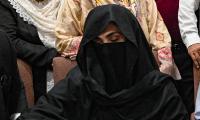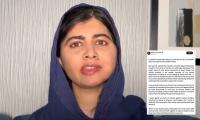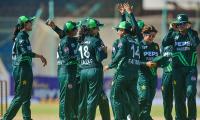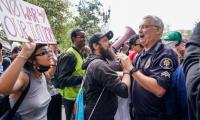Surrounded as we are by grave issues in the national, regional and global spheres, let me first talk about a poet who is dead for a century and a half.
But that does not mean that I want to escape from the pain of the present calamities. In fact, I find the poet to be particularly relevant at this time.
Well, it is obvious that I am talking about Ghalib, our beloved Ghalib, who is arguably the greatest of all Urdu poets. One excuse to remember the poet would be that February 15 this year marked his 150th death anniversary. That this occasion did not create any conspicuous stir in the literary world of Pakistan is another matter.
On the other hand, of course, there is this heady rush of literary festivals in the major cities, presenting almost the same fare to a culturally impoverished intelligentsia. A major show was staged in Lahore last weekend and the presence of Orhan Pamuk, the Turkish writer who has won the Nobel Prize for Literature, made all the difference. This weekend we have the 11th Karachi Literature Festival, the forerunner of these gala affairs.
To that extent, the literary festivals and the KLF this week could provide justification for a discourse on poetry as such and on our great poets such as Ghalib. But the reason I have Ghalib on my mind is located in an entirely separate territory. It is Delhi. This week’s Delhi.
We may detect the shadow of South Asia’s dark and bloodied history in the rioting that took place in the largely Muslim neighbourhoods of northeast Delhi earlier this week. The spectre of communal violence continues to return again and again since that incredible madness of 1947. Is this what the Subcontinent has made of its freedom?
Details of what happened are horrendous because of the visible endorsement of the anti-Muslim violence by the leaders of Narendra Modi’s Hindu nationalist party. So much so that two judges of the Delhi High Court had to sit past midnight to order the police to take the injured to a hospital. And a judge of the same court was promptly transferred after he named ruling party politicians for instigating the riots.
It seemed natural to detect in this Delhi tragedy the reverberations of the massacre of Muslims in Gujarat in 2002, when Modi was chief minister of the state and his complicity is well documented. At another level, this week’s unchecked violence revived the memories of the 1984 anti-Sikh pogrom in Delhi. Visual images of the communal violence, gathered by intrepid journalists who were also under attack by the goons, project an apocalyptic view of India’s history.
Observers have noted that this anti-Muslim violence appeared to be pre-planned. In some ways, it was the culmination of the police brutalities during peaceful demonstrations against the controversial citizenship law, staged across India. Though the law is manifestly against Muslims, its opposition was bolstered by progressive and liberal elements of the entire Indian civil society.
Hindutva fanatics are unwilling to put up with this endorsement of a secular polity that is sanctioned by the Indian constitution. For them, the problem is entirely communal. This recourse to identity politics in South Asia is bound to generate animosity and violence. In that sense, prospects for peace and harmony now seem frightfully restricted.
You may ask: what has Ghalib got to do with all this? I may be stretching it a bit, but Ghalib has a mythical relationship with historical Delhi. He had suffered the pain of living through some of the most tumultuous times and had the genius of elucidating the situation in his verse and his prose, mainly the letters that he wrote to his friends and benefactors.
So, one thought is that Delhi, in its present moment of agony, is deprived of someone who could tell its story. There is also this feeling that only poets and creative writers are able to grasp the human experience of living in challenging times. This is not a task for poor scribes or for historians who build their narratives on lifeless facts.
It was Ghalib who brought to life for us the Delhi of 1857 and thereabouts just as Manto has been the most candid observer of the insanity of the communal riots in 1947. And this reminds me of that astonishing novel of Rabisankar Bal, in Bangla, titled ‘Dozakhnama’. We got to read it in its English translation and now we also have an excellent Urdu version.
Subtitled ‘Conversations in Hell’, it is an account of Ghalib and Manto writing letters to each other while they are lying in their graves. What we have, in this portrayal of magical realism, is a juxtaposition of two of the most traumatic times in South Asia through the eyes and experiences of Ghalib and Manto.
What we saw in Delhi this week does have some intimations of those dark days. Incidentally, Indian newspaper The Telegraph has highlighted the ‘CHILLING COINCIDENCE’ of something happening in Delhi on February 26 2020 that was an exact replay of what had happened in Gujarat on February 28, 2002. On both occasions, calls made to the police for help by an important politician went unheeded.
Apart from the high death toll during the first three days of rioting – close to 40 – and injuries caused mainly by bullets, extensive damage was done to properties belonging to Muslims. Houses and shops were ransacked and set on fire. Delhi was burning. One hashtag on Twitter was: DelhiBurning.
‘Is Paris Burning?’ was a 1965 book by Larry Collins and Dominique Lapierre, the duo that a decade later wrote ‘Freedom at Midnight’ to describe events around Partition. In terms of human tragedies, there is no parallel to the Second World War. But the title is interesting.
It is taken from the question reportedly asked by Adolf Hitler following his order to destroy the city rather than let it be re-captured by the Allies. Could a BJP leader have posed a similar question to a local police official in northeastern Delhi on Tuesday or Wednesday?
The writer is a senior journalist.
Email: ghazi_salahuddin@hotmail.com
A representational image showing residents walking at a wholesale market in Karachi. — AFP/FileOnce again there is...
A representational image showing late Pakistani human rights activist and Supreme Court lawyer Asma Jahangir. —...
A representational image showing a security personnel sanding guard beside a ship carrying containers at Gwadar port....
A health worker administers polio vaccine drops to a child during a door-to-door polio vaccination campaign in Lahore,...
Armed militants of the banned Tehreek-e-Taliban Pakistan pose for a photograph in Orakzai Agency. —...
An aeroplane of the national flag carrier of Pakistan is seen in this file photo. — AFPWhile Pakistan considers...







